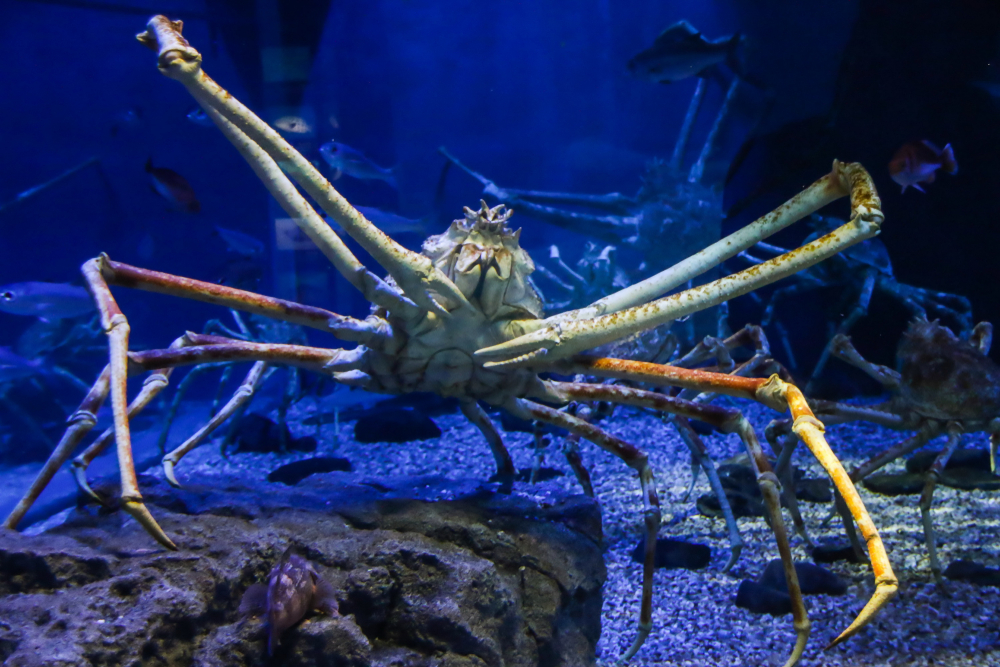The deeper you go, the bigger they get. This is an adage that applies to much of the life eking out an existence in the crushing depths of our oceans. Near the surface, tiny crabs are terrified of larger predators. In the deep, 13-foot-wide are usually the predators themselves.
Perhaps the most infamous example of this deep-sea gigantism is the giant squid, capable of attaining lengths of and possibly even longer should it stretch out its tremendous tentacles. Giant isopods, giant jellyfish, even giant amoebas, the list goes on. But just what is driving this varied cast to get so extravagantly sized?
Are Bigger Animals More Efficient?
One potential explanation is that the deep sea is very dark, cold, and far from the surface where most other life lives. As a result, food, usually in the form of falling bits of detritus called, is sparse. It pays to be efficient with your scarce energy, and as a general trend, bigger critters tend to be more efficient.
The answer lies in a mathematical model called. The larger you make an organism, the less energy it requires relative to its mass. For instance, a cat one hundred times the weight of a mouse only requires around thirty times as many calories.
The exact mechanism is still a subject of debate, but it may be related to a greater volume, allowing animals to retain more heat from metabolism. When you’re a hungry animal unsure of when or what your next meal will be, it’s best to be prepared for anything that comes your way, no matter the size. The gulper eel’s gaping maw or the grotesquely extendable stomach are but a few examples of the opportunistic feeding habits of these deep-sea denizens.
What Other Factors Explain Large Sizes?
Nonetheless, Kleiber’s relatively simplistic rule the total picture when it comes to supersized organisms. A 2015 published in Plant Signaling and Behavior found that the predictions espoused by the model don’t align with the proportions seen in various plant species. Environmental or evolutionary factors may be more important in regards to explaining such adaptations.
is another attempt to generalize size relationships, only this time as a function of temperature. The trend can be observed among many warm-blooded animals. For instance, the are far taller and heavier than any of their warm-water counterparts.
After all, being larger means that you lose less warmth to the environment relative to your heat-generating body mass. For an animal that wants to stay toasty, this polar gigantism comes in quite handy, especially when average land temperatures in Antarctica -20 degrees Fahrenheit.
Even for the creatures of the deep sea, lower temperatures may help larger body sizes. Being cold-blooded,, resulting in slower growth but also less wear and tear over time. The result is a longer growing period due to a longer lifespan and a reduced need for food. Cold, deep water can also hold more oxygen, potentially allowing large animals to breathe more easily.
To put this into perspective, enter the Greenland shark. These Arctic-dwelling fish eat just about anything their sluggish speeds let them catch, including caribou that wander into the water. Their metabolism is so slow that a modestly sized 500-pound shark only needs a few ounces of meat per day to feed itself, according to a 2022 published in the Journal of Experimental Biology.
As such, a single fish can keep the sharks fed for a week; a whole mammal carcass leaves them sated for months. The metabolic crawl of the cold-water Greenland sharks also gives them a maximum known lifespan of, a record among vertebrates.
What Makes Whales So Big?
The chilly, oxygen-rich environment allows for large sizes, and the impetus to efficiently capitalize on available food, and to avoid being eaten, may pressure life to attain those dimensions. But even the most fearsome deep sea squids pale in comparison to the leviathan scales of the great whales. What drives a behemoth like the ?
Interestingly, the so-called great whales were pretty small up until pretty recently. Only about 5 million years ago, filter-feeding baleen whales like rarely exceeded 20 feet in length. It was only after the Earth cooled and glaciated, and large polar ice caps formed, that the whales really took off growing.
Cold water carries more oxygen, but also facilitates upwelling of nutrient-rich bottom water, enabling. This in turn fuels equally tremendous swarms of krill, the preferred meal of blue whales. The intermittent, seasonal availability of this food source meant that whales needed to travel greater distances to find it, and last through longer periods of starvation.
In accordance with Kleiber’s rule, a larger animal should not only be more efficient but also able to store a larger portion of its weight in fat reserves. A 2019 published in eLife found a strikingly “Kleiber-esque” correlation between mass and energy stores in rapidly growing worms called planarians.
Blue whales are no worms, but they may have followed a similar pattern. Their large size allowed them to in search of sparse areas of this higher productivity, as well as enabling the beasts to capitalize on food when they found it.
Of course, being bigger isn’t always better. A larger animal needs more food, takes longer to reproduce, and is more affected by ecosystem collapse. Nonetheless, these larger-than-life offerings of evolution will hopefully continue to captivate us and inspire conservation.
